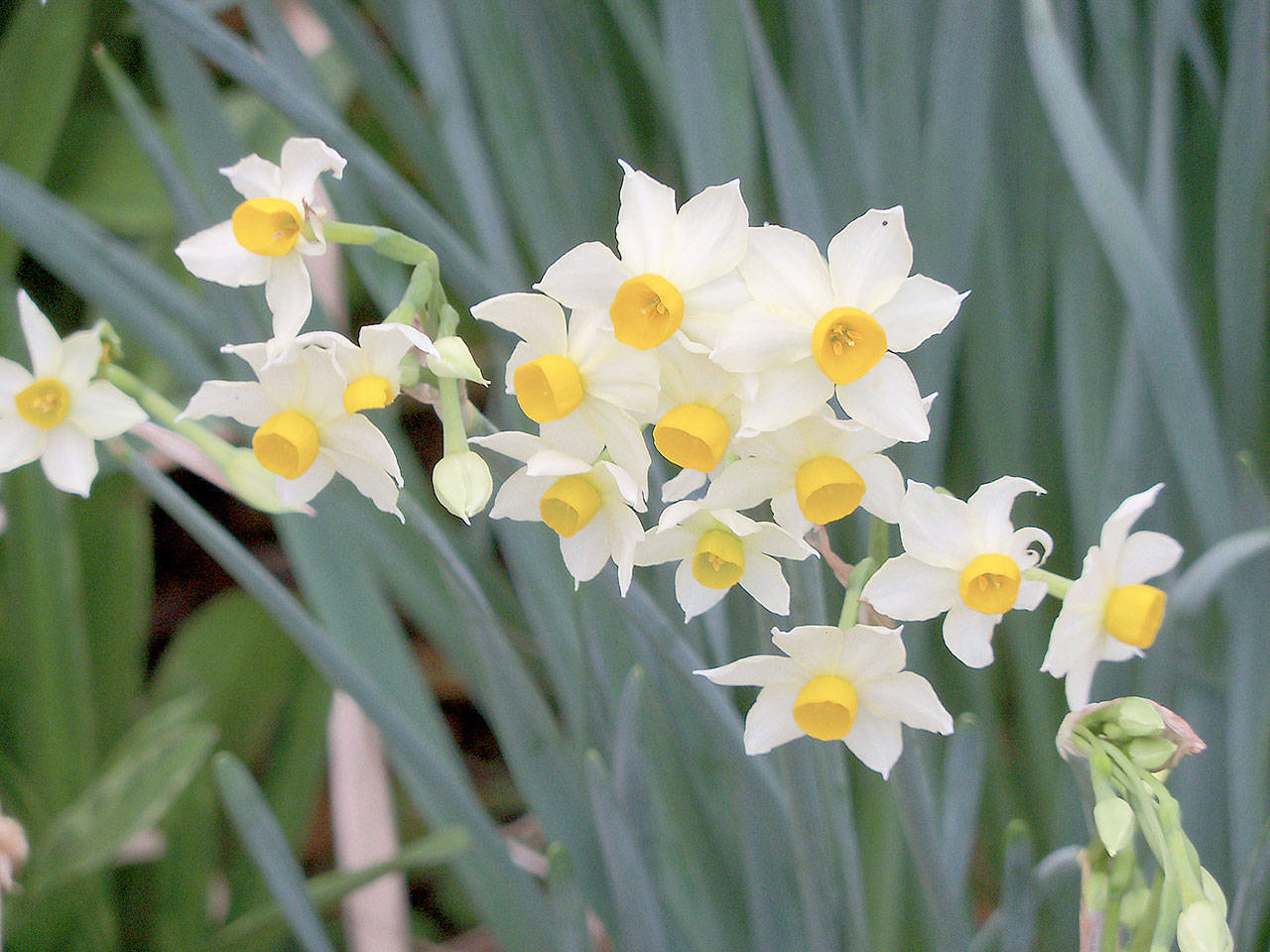By Dolores Cavanah
WSU Master Gardener
Narcissus is one of the first spring flowers to appear — much to the delight of those who are ready for breaking the spell of winter in the garden.
Narcissus grows from a bulb and will thrive when planted in well-drained soil. Very distinctive with its long, narrow tubular stem and narrow swordlike leaves, it has three petals like sepals and a central cup-like appendage, or crown. Narcissus flowers are usually white or yellow and may have a contrasting crown color. They are well-loved by hungry bees.
The name has its roots in Greek mythology. The young man named Narcissus was so incredibly handsome that he fell in love with his own reflection in a pool of water. It is said that his blood turned into the flowers that now bear his name.
Highly fragrant, Narcissus is one of the most popular bulbs in the world and is the most popular in Germany. Native to the Mediterranean, Narcissus can also be found in China and Central Asia. The most common Narcissus species found growing throughout North America today came from Europe with early colonists and migrated west with settlers.
Daffodils, with a modern large-flowered blossom, are the most familiar type of Narcissus planted today. Native Narcissus occurs in meadows, woodlands, along water courses and in rocky outcroppings up to sub-alpine altitudes.
The genus Narcissus encompasses dozens of species, hybrids and varieties, including flower bulbs such as jonquils, daffodils and paperwhites. Narcissus are classified into13 divisions according to either their flower forms or botanical name: Trumpet, Large-cupped, Small-cupped, Double, Split corona, Triandrus, Cyclamineus, Jonquilla, Tazetta, Poeticus, Bulbocodium, and two Miscellaneous divisions. The term ‘heirloom’ loosely refers to bulbs existing before 1940.
In gardener terms, “daffodil” refers to large-flowered kinds; “narcissus” denotes small-flowered types that bear blossoms in clusters, and “jonquil” refers to the Jonquilla divisions, and hybrids.
Narcissus is one of my favorites in the garden because of its ease in planting, minimal care requirements and readily available bulbs. The bulbs are permanent, increasing from year to year. They will stand up to cold (Zone 5) and heat, and are completely unappetizing to moles and deer.
Narcissus does not like high-nitrogen fertilizer. Any gardener who wants to make sure of knock-out blooms should use a high-phosphorous fertilizer.
Plant bulbs in autumn in well-drained soil in full sun or partial shade. Bulbs should be planted one to one and one-half times the bulb’s height and spaced 6 to 8 inches apart. Water newly planted bulbs thoroughly and keep plants well-watered throughout the flowering season until foliage begins to yellow, at which time water is not necessary.
It is important is to leave foliage on until fully matured, allowing it to yellow or brown naturally. Spent flowers can be deadheaded after bloom. The dying leaves nourish the bulbs to continue their growth cycle for the next year. If planted among later-emerging perennials in spring, the yellowed and withered leaves are hidden on the ground by the new growth of the perennial.
Clumps need dividing only when blooms lessen or quality declines. Naturalizing with sweeping drifts where space is available makes a stunning display in early spring.
Ellen Willmott (1858-1934), a noted English gardener, specialized in large swaths of daffodil blooms at her home in Great Britain. People would come from all around to enjoy the display. So concerned was she that the plants might be damaged, she instructed her gardeners to install tripwires with air guns throughout the daffodil fields, to frighten anyone trying to pick a bouquet.
This article, by Master Gardener Dolores Cavanah, is part of an occasional series in which she describes the plants she most admires at her expansive garden at Schafer Meadows, east of Montesano.
Advice online
Do you have a problem with a plant? Do you want some help with disease prevention in your vegetable garden? Do you need help finding the right vegetable seed? Ask WSU Master Gardeners! Go to PNWMG.org and post your question near the bottom of the home page, where you see “Ask a Master Gardener.”


